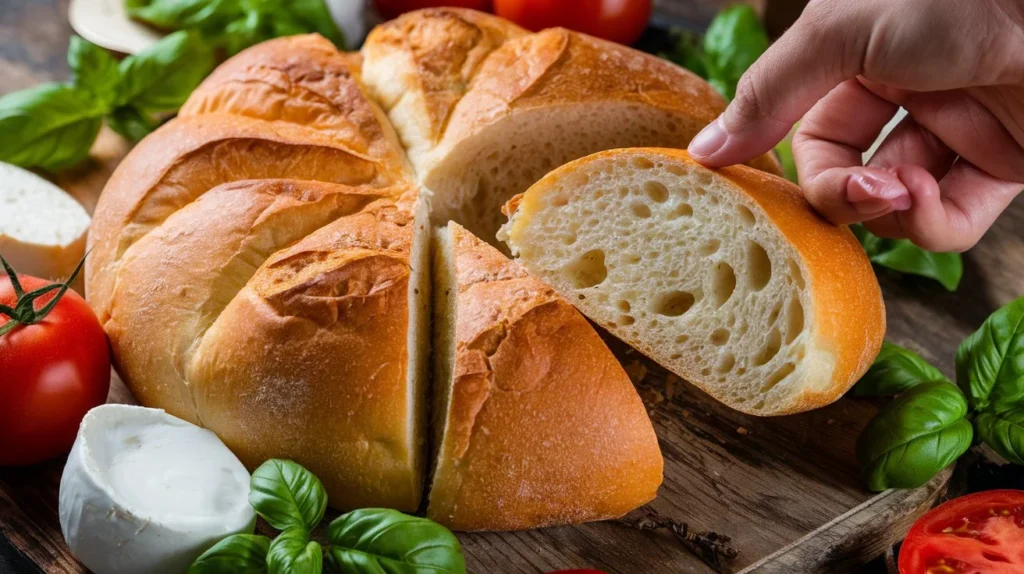
Have you ever wondered what makes the best bread for panini sandwiches? Whether you're crafting a quick lunch or a gourmet creation, the bread can make all the difference. A great panini bread isn’t just a vessel—it’s the foundation of a perfectly pressed sandwich, delivering a soft interior and a golden, crisp exterior.
In this recipe, I’ll show you how to create the best panini bread at home. It’s simple, foolproof, and customizable to suit any filling, from classic Italian combos to your favorite creative twists. So, let’s dive in and make a panini bread recipe that will elevate every sandwich into a masterpiece!
Table of Contents
Key Benefits of Making Homemade Panini Bread
Making your own panini bread at home is not just rewarding—it’s a game-changer for your sandwiches. Here’s why:
- Unbeatable Freshness: Homemade bread has a soft, airy texture with a crisp crust that store-bought options just can’t match.
- Customization at Its Best: From adding herbs like rosemary to experimenting with whole wheat flour, you can tailor this recipe to your preferences.
- Versatility: This bread isn’t just for paninis! Use it for wraps, bruschetta, or as a side to your favorite soups and salads.
- Cost-Effective and Healthier: Making your own bread means fewer preservatives, better ingredients, and a happier wallet.
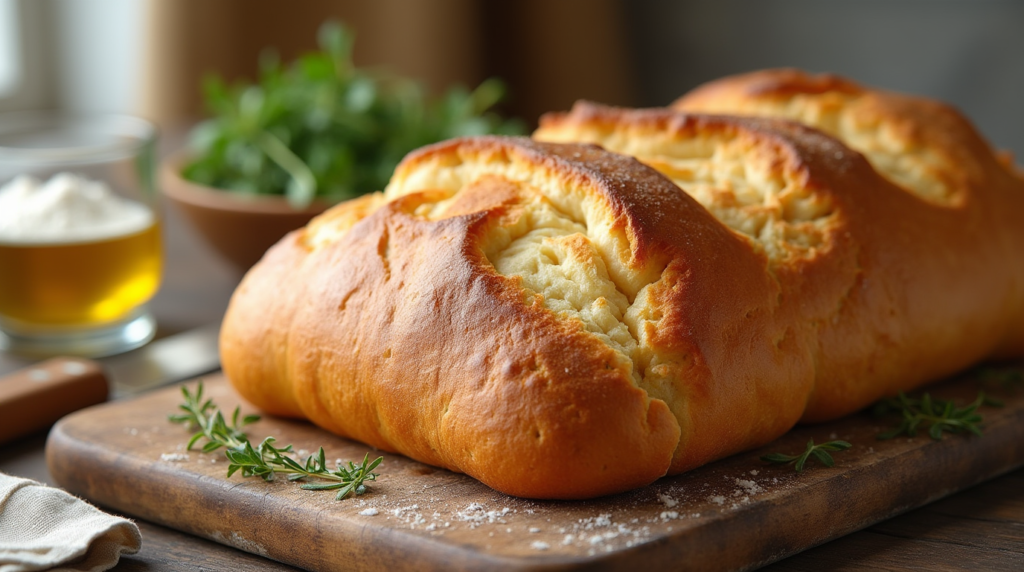
When you bake this bread, you’re creating the perfect foundation for the best panini sandwiches. Whether you love classic combos like mozzarella and tomato or want to try something bold like grilled vegetables with pesto, this panini bread recipe has you covered. Plus, nothing beats the aroma of freshly baked bread filling your kitchen—it’s truly the best!
Let’s dive into the ingredients and steps to get started on this delicious journey.
Ingredients
Before we get started, let’s gather everything you need to make the best panini bread at home. These simple, pantry-friendly ingredients come together to create a foolproof dough that’s soft, fluffy, and perfect for sandwiches.
Essential Ingredients
- 3 ½ cups all-purpose flour: Provides structure and a soft texture. You can substitute with bread flour for a slightly chewier result.
- 1 packet (2 ¼ tsp) active dry yeast: Helps the dough rise and creates that fluffy interior.
- 1 ¼ cups warm water: Activates the yeast—make sure it’s warm (not hot) to avoid killing it.
- 2 tbsp olive oil: Adds richness and a subtle flavor.
- 1 tbsp sugar: Feeds the yeast and gives the bread a hint of sweetness.
- 1 tsp salt: Balances the flavors.
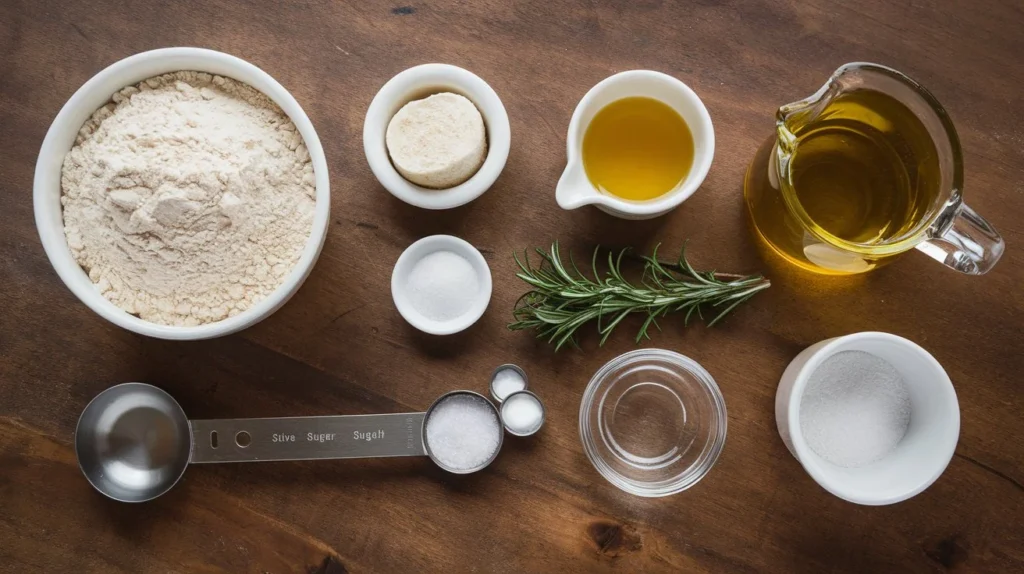
Optional Add-ins
- 1 tbsp dried herbs (like rosemary, thyme, or oregano): For a Mediterranean twist.
- 2 tbsp grated Parmesan cheese: Adds a savory, cheesy note.
- 1 tsp garlic powder: For a flavorful kick.
Tools You’ll Need
- Mixing bowls
- Measuring cups and spoons
- A wooden spoon or a stand mixer equipped with a dough hook
- Kitchen towel for covering the dough
- Baking sheet or pizza stone
With these ingredients and tools ready, you’re just a few steps away from creating the best bread for panini sandwiches. Next, we’ll dive into the step-by-step instructions to bring this dough to life!
Instructions
Making the best panini bread is easier than you think! Just follow these step-by-step instructions, and you’ll have fresh, golden bread ready to elevate any sandwich.
Step 1: Activate the Yeast
- Mix the warm water and sugar together in a large bowl. Stir until the sugar dissolves.
- Scatter the yeast over the mixture and let it sit for 5–10 minutes. When the surface turns frothy, you’ll know the yeast is activated and ready to use.
Step 2: Prepare the Dough
- Add the olive oil, salt, and 2 cups of flour to the bowl. Mix well using a wooden spoon or a stand mixer fitted with a dough hook.
- Gradually add the remaining flour, about ½ cup at a time, while mixing until the dough starts to come together. It should be soft and slightly sticky but easy to handle.
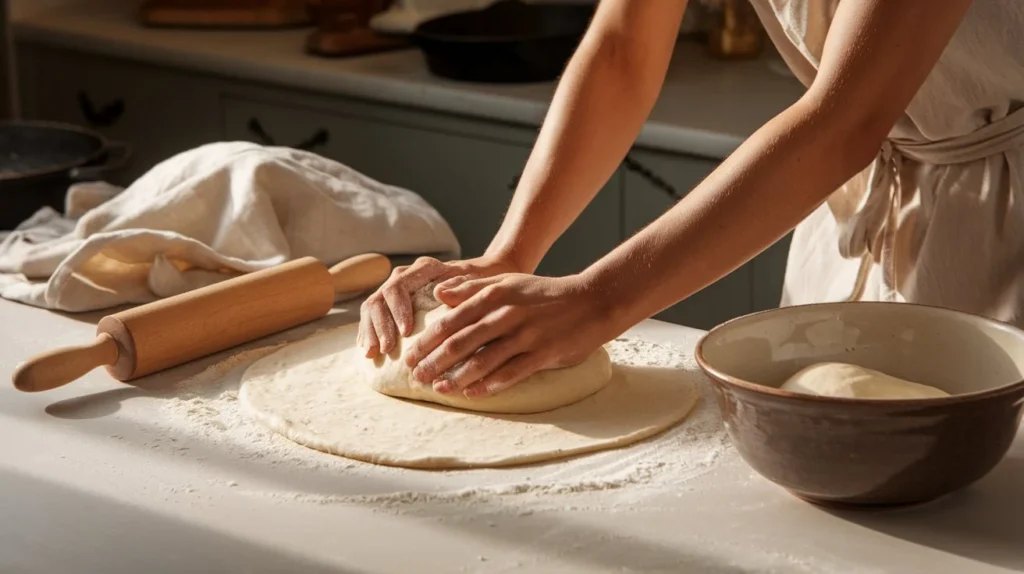
Step 3: Knead the Dough
- Turn the dough out onto a lightly floured surface and knead by hand for 8–10 minutes. If using a stand mixer, knead on medium speed for 5–6 minutes.
- The dough is ready when it becomes smooth, elastic, and slightly springy to the touch.
Step 4: First Rise
- Place the dough in a lightly greased bowl, turning it once to coat the surface. Cover with a clean kitchen towel.
- Let the dough rise in a warm spot for 1–1.5 hours or until it doubles in size.
Tip: If your kitchen is on the cooler side, use your oven with the light on to create a warm environment.
Step 5: Shape the Bread
- Deflate the risen dough gently by pressing it down to remove any air bubbles. Divide it into 4–6 equal portions, depending on the size of the bread you prefer.
- Shape each portion into flat ovals or discs, about ½ inch thick, perfect for panini sandwiches.
Step 6: Second Rise
- Place the shaped dough pieces on a baking sheet lined with parchment paper. Cover lightly with a towel and let them rise again for 30–40 minutes.
Step 7: Bake Your Bread
- Preheat your oven to 375°F (190°C).
- Bake the bread for 15–18 minutes, or until the tops are golden and the loaves sound hollow when tapped.
- Take the bread out of the oven and allow it to cool on a wire rack before slicing or serving.
And there you have it—soft, fluffy panini bread that’s perfect for making the best panini sandwiches or enjoying fresh out of the oven. Get ready to impress your taste buds!
Pro Tips for Perfect Panini Bread
- Check the Water Temperature: When activating yeast, aim for water between 105°F and 110°F. Too hot, and you’ll kill the yeast; too cold, and it won’t activate.
- Use the Windowpane Test: To check if the dough is kneaded enough, stretch a small piece between your fingers.
- Avoid Over-flouring: While kneading, use just enough flour to keep the dough from sticking. Adding too much can make the bread dense.
- Preheat Your Oven Properly: Ensure the oven is fully preheated before baking to achieve an evenly golden crust.
- Create a Steamy Environment: Place a small pan of water in the oven while baking to enhance the bread’s crustiness.
Delicious Variations to Try
- Herb-Infused Bread: Mix in 1–2 tablespoons of dried herbs like basil, oregano, or rosemary for an Italian-inspired twist.
- Cheesy Delight: Add ¼ cup of grated Parmesan or cheddar to the dough for a savory, cheesy flavor.
- Whole Wheat Option: Replace half the all-purpose flour with whole wheat flour for a heartier, more nutritious bread.
- Garlic and Herb: Blend in 1 teaspoon of garlic powder and a sprinkle of dried thyme for a flavor-packed loaf.
- Sweet and Savory: Add a drizzle of honey or a handful of chopped olives to the dough for unique flavor combinations.
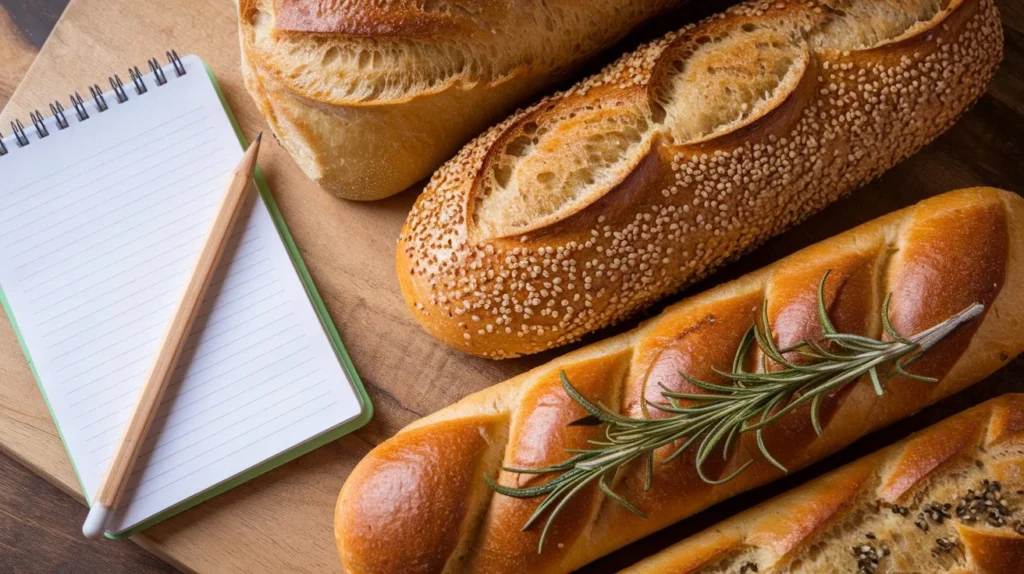
Troubleshooting Common Issues
- Bread Didn’t Rise: Check the yeast’s freshness and ensure the water temperature was correct.
- Dough Feels Too Sticky: Gradually add a small amount of flour, a tablespoon at a time, while kneading.
- Crust Too Hard: Cover the bread with a clean kitchen towel as it cools to soften the crust.
Experimenting with these tips and variations allows you to make panini bread that suits your taste and style. Whether you prefer a classic loaf or a creative twist, the possibilities are endless!
Serving Suggestions
Now that your homemade panini bread is fresh out of the oven, it’s time to transform it into irresistible dishes. Here are some serving ideas to help you enjoy the best panini sandwiches and more!
Classic Panini Creations
- Caprese Panini: Layer fresh mozzarella, juicy tomato slices, and basil leaves. Add a drizzle of olive oil and balsamic glaze for a simple yet delicious Italian-inspired sandwich.
- Turkey and Avocado: Combine sliced turkey, creamy avocado, and your favorite cheese. Grill until the bread is golden and the cheese melts beautifully.
- Grilled Veggie Delight: Fill with roasted zucchini, eggplant, and bell peppers. Spread a layer of hummus or pesto for extra flavor.
Beyond Sandwiches
- Bruschetta Base: Slice and toast your bread, then top with diced tomatoes, garlic, basil, and a drizzle of olive oil for a quick appetizer.
- Breakfast Boost: Use the bread as a base for avocado toast, topped with a poached egg and a sprinkle of red pepper flakes.
- Soup Companion: Pair a slice of panini bread with creamy tomato soup or minestrone for a comforting meal.
Creative Panini Pairings
- Cheese Platter Addition: Serve small slices alongside a selection of cheeses, cured meats, and fruits for an elegant charcuterie board.
- Dips and Spreads: Cut the bread into strips and enjoy with spinach artichoke dip, tzatziki, or garlic butter.
- Sweet Treats: Toast the bread lightly and spread with Nutella, peanut butter, or honey for a quick and satisfying dessert.

Tips for the Perfect Serving
- Warm the bread slightly before serving to bring out its fresh aroma and soft texture.
- Use a panini press or grill pan to create those signature golden grill marks for sandwiches.
- Keep any leftover bread fresh by storing it in an airtight container. Alternatively, you can freeze it for up to a month—simply thaw and warm it up when ready to enjoy.
With these serving suggestions, your panini bread becomes more than just a sandwich base—it’s the star of any meal. Get creative and enjoy this versatile bread in countless delicious ways!
Conclusion
Making your own panini bread at home is not only rewarding but also opens up endless possibilities for delicious meals. From crafting the best panini sandwiches to experimenting with creative variations, this recipe allows you to customize each loaf to suit your taste and preferences.
Homemade panini bread offers a level of freshness and flavor that store-bought options simply can’t match. Plus, the satisfaction of baking your own bread—from kneading the dough to savoring that first warm slice—adds a special touch to every meal.
Whether you’re serving it with hearty soups, creating gourmet sandwiches, or enjoying it with your favorite dips, this versatile bread is sure to impress family and friends. By following the tips and techniques shared in this guide, you’ll achieve perfect results every time.
Ready to get started? Dive into the recipe and experience the joy of homemade panini bread. It’s time to elevate your cooking game and create something truly unforgettable in your kitchen!
FAQs
1. What is the best bread for panini sandwiches?
The best bread for panini sandwiches is one that holds up well under grilling without becoming soggy or too dense. Homemade panini bread is ideal because it strikes the perfect balance between a soft interior and a sturdy crust. Other great options include ciabatta, focaccia, and baguettes
2. Can I use whole wheat flour for this panini bread recipe?
Absolutely! Replace up to half of the all-purpose flour with whole wheat flour for a more nutritious option. Keep in mind that whole wheat flour may make the bread slightly denser, so consider adding an extra teaspoon of water if the dough feels too dry.
3. Do I need a panini press to make panini sandwiches?
No, you don’t need a panini press! A grill pan or a flat skillet works just as well. Simply press the sandwich with a heavy object, like a cast-iron pan, to mimic the effect of a press.
4. How can I store leftover panini bread?
To keep leftover bread fresh, store it in an airtight container at room temperature for up to 3 days. To store the bread longer, freeze it for up to a month. Thaw it at room temperature and warm it up before serving.
5. Can I prepare the dough in advance?
Yes, you can make the dough ahead of time!Yes, you can prepare the dough ahead of time! After the first rise, punch it down, cover it tightly, and store it in the refrigerator for up to 24 hours. When you’re ready to bake, allow the dough to come to room temperature, shape it, and let it rise again before baking.
6. What toppings can I add to the dough before baking?
Get creative with your toppings! Sprinkle sesame seeds, poppy seeds, or a dusting of coarse sea salt on top of the dough before baking. You can also brush the surface with olive oil and add chopped rosemary or garlic for extra flavor.
7. Why didn’t my bread rise properly?
If your bread didn’t rise, check these common issues:
The yeast may have expired. Always use fresh yeast for the best results.
The water used to activate the yeast might have been too hot or too cold. Aim for a temperature of 105°F to 110°F.
The dough may have been left in a drafty or cool spot. Ensure the yeast is fresh for the best results.
8. How do I make my panini sandwiches extra crispy?
Brushing the bread with olive oil or melted butter creates a lovely golden crust and enhances its flavor.
These FAQs address the most common questions, ensuring you’re fully equipped to make and enjoy the best panini bread every time!